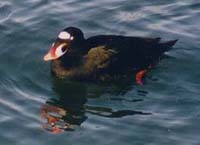
Harlequin Duck Distribution
and Productivity in BC
and Productivity in BC
Research on Sea Ducks

 |
Harlequin Duck Distribution
and Productivity in BC Research on Sea Ducks |
 |
| This project is designed to address, on a regional scale, the factors that influence harlequin duck distribution and productivity in the southern Coast Mountains of British Columbia. This research provides the scientific background necessary to understand how variation in habitat (including that related to hydroelectric operations and other human activity) affects harlequin ducks, and prescribes concrete mitigation or restoration activities that would improve harlequin duck productivity. A primary objective of the research is to develop models describing the relationship between harlequin duck distribution and habitat attributes (for example, stream gradient, width, substrate, vegetation, prey availability, fish presence, etc) at a regional scale. |  |
In addition to the broad-scale description of patterns in harlequin duck distribution and productivity, we are addressing two specific mechanisms that we consider critically important for understanding how breeding habitat (and changes to that habitat) influence harlequin duck productivity:
Answers to these questions will provide insight into links between food, tropic interactions, and subsequent harlequin duck productivity. |
| CWE Researchers on this project: Dan Esler Jeanine Bond Sunny Lebourdais Ron Ydenberg Sam Iverson Ramunas Žydelis Ken Wright |
Research Partners:
|